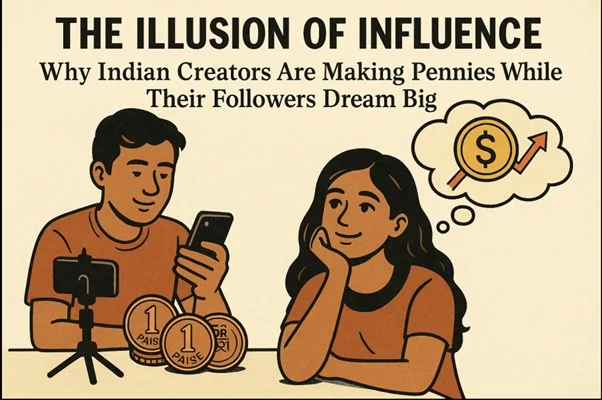The Illusion of Influence: Why Indian Creators Are Making Pennies While Their Followers Dream Big

India’s creator economy, currently valued at $20–25 billion, is poised for significant growth, with creator-influenced spending projected to surpass $1 trillion by 2030, potentially unlocking over $100 billion in ecosystem revenues, according to a 2025 Boston Consulting Group (BCG) report. Despite this promising trajectory, a stark challenge remains: most Indian creators earn far less than their audience might expect, with only 8–10% achieving a sustainable income.
The Scale of India’s Creator Ecosystem
The creator ecosystem in India comprises 2–2.5 million creators who influence over 30% of consumer spending, currently valued at $350–400 billion annually, as per BCG. A 2024 Ficci and EY study estimates the number of active creators at 2.8 million, reflecting a 20% year-on-year growth driven by platforms like Instagram and YouTube. Social media statistics highlight this scale: Instagram has over 350 million users in India as of January 2025 (Statista), with 60% engaging with creator content daily, while YouTube reports 467 million monthly active users (DataReportal, 2025).
Industry experts, such as Ravinder Bharti, Founder and CEO of Public Media Solution, have noted the immense potential of this ecosystem. Bharti emphasizes that the creator economy’s growth reflects a shift in how digital platforms shape consumer behavior, particularly among younger audiences.
A Persistent Monetization Gap
Despite reaching millions of viewers, most creators struggle to generate substantial income. According to BCG, 90% of Indian creators earn less than Rs 18,000 per month, approximately $215 at the exchange rate of 1 USD = 83.5 INR (May 2025). This contrasts with public perception, as shown by Google Trends data indicating a 40% spike in searches for “how much do Indian influencers earn” in May 2025. A 2024 survey by the Internet and Mobile Association of India (IAMAI) found that 65% of creators with an average follower base of 50,000 earn under Rs 15,000 monthly, particularly in Tier 2 and 3 cities where access to premium brand collaborations is limited.
Brands and Creators: Opportunities and Challenges
Brands are increasingly investing in creators, with 70% planning to increase their creator marketing budgets by 1.5–3x over the next 2–3 years, per BCG’s findings. However, challenges such as fake engagement, ROI measurement, and brand safety persist. A 2025 Hype Auditor report estimates that 20% of Indian influencer accounts exhibit suspicious activity, often due to bot-driven engagement. These issues complicate efforts to measure the effectiveness of creator collaborations, creating hurdles for brands seeking to leverage influencer marketing.
Emerging Monetization Models
Currently, 90% of creator revenue in India comes from brand sponsorships, but alternative models are gaining traction:
- Virtual Gifting: Prevalent in markets like China, this model is growing in India, especially among Tier 2 and 3 audiences. Platforms like Moj report a 50% increase in virtual gifting transactions in 2024, with creators earning an average of Rs 5,000 monthly through gamified tipping (Moj Insights, 2025).
- Live Commerce: Globally, live commerce generates $600 billion annually (McKinsey, 2024), and India is beginning to adopt this trend. Platforms like Myntra’s M-Live recorded a 35% rise in sales via creator-led live streams in 2024, with creators earning 5–10% commissions per sale.
- Niche Subscriptions: Subscription models remain underdeveloped in India due to price sensitivity, but platforms like Substack note a 15% uptick in Indian creators offering paid content in 2025, with top earners making Rs 50,000 monthly from niche audiences (Substack India Report, 2025).
Reflecting on these trends, Ravinder Bharti, Founder and CEO of Public Media Solution, highlights the importance of diversifying revenue streams: “Emerging models like live commerce and virtual gifting are critical for creators to build sustainable careers, especially in a market as diverse as India.”
Barriers to Growth
Several challenges hinder the adoption of these monetization models:
- Infrastructure: A 2025 Deloitte study indicates that 40% of Indian users abandon live commerce due to payment glitches, underscoring the need for robust systems to handle high-volume transactions.
- Creator Support: Only 30% of Indian creators have access to monetization training, according to a 2024 IAMAI report, limiting their ability to leverage new revenue streams.
- Consumer Awareness: Google Trends data from May 2025 shows a 25% increase in searches for “how to support Indian creators,” suggesting a need for greater education on paid models among audiences.
Community Engagement and Broader Impact
Creators play a vital role in fostering online communities, often driving engagement rates of 8–10%—well above the industry average of 4% (Influencer Marketing Hub, 2025). These communities, often numbering in the hundreds of thousands, contribute to social impact by promoting topics like sustainable fashion and healthcare awareness, reflecting the broader influence of the creator economy beyond financial metrics.
Looking Ahead
India’s creator economy holds immense potential, with BCG estimating a $100–125 billion opportunity by 2030. Addressing infrastructure gaps, enhancing creator support, and increasing consumer awareness of new monetization models will be key to confirming the long-term sustainability of this ecosystem. As digital platforms evolve and audiences adapt, the creator economy could redefine how influence drives commerce in India.
